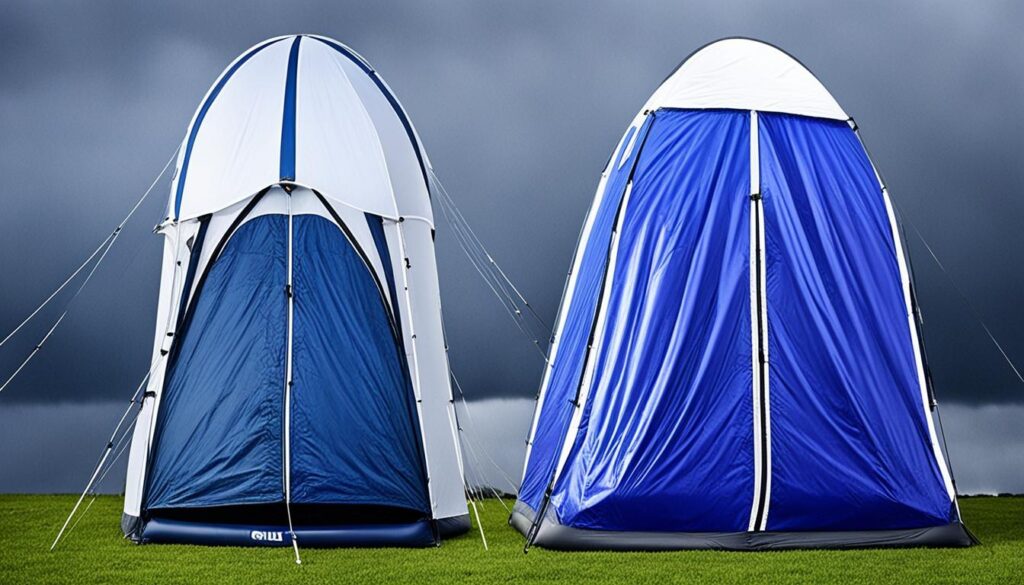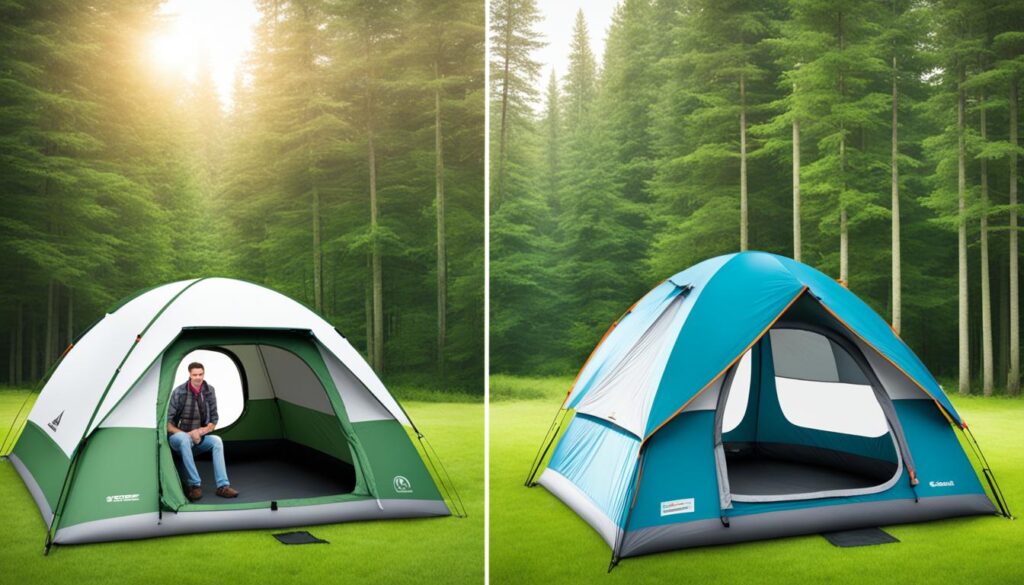When it comes to camping, choosing the right tent can significantly impact your outdoor experience. Inflatable tents and traditional pole tents are two popular options, each with its own set of benefits and considerations. But which is the ultimate camping choice?
In this article, we will compare inflatable tents and traditional tents, examining their differences, advantages, and drawbacks. Whether you’re a seasoned camper or a beginner looking to invest in the perfect tent, understanding the key factors can help you make an informed decision.
Key Takeaways:
- Compare the benefits and drawbacks of inflatable and traditional tents.
- Consider factors such as setup time, cost, durability, and comfort.
- Inflatable tents provide easy setup and spacious interiors, while traditional tents are cost-effective and space-efficient.
- Durability and weather resistance vary between inflatable and traditional tents, but both offer reliable shelter.
- Cost analysis involves considering upfront costs as well as maintenance and replacement expenses.
Lightweight and Easy to Set Up
When it comes to camping, having a tent that is lightweight and easy to set up can make a world of difference. Whether you’re a seasoned outdoor enthusiast or a beginner camper, the convenience and functionality of your camping gear can greatly enhance your overall experience. In this section, we will explore the advantages of lightweight camping tents and compare the setup processes of inflatable tents and traditional tents.
Inflatable Tents: Easy Setup and Lightweight Design
Inflatable tents are revolutionizing the camping industry with their easy setup and lightweight construction. These tents utilize air beams or tubes instead of traditional poles, allowing for a quicker and hassle-free pitching process. With inflatable tents, there’s no need to fumble with multiple poles and struggle to align them correctly. Instead, simply inflate the beams, and your tent takes shape in a matter of minutes.
One of the key benefits of inflatable tents is their lightweight design. Made from durable yet lightweight materials, these tents are much easier to carry and transport compared to their traditional counterparts. This is particularly advantageous for backpackers and hikers who value every ounce of weight they carry on their adventures. Additionally, the compact size when deflated makes inflatable tents highly portable, fitting easily into backpacks or storage compartments.
Inflatable tents also offer excellent stability once pitched. The air beams provide a strong and rigid structure, ensuring that the tent can withstand various weather conditions, including wind and rain. The stability and durability of inflatable tents make them a reliable choice for campers seeking a hassle-free setup and peace of mind during their outdoor excursions.
Traditional Tents: Tried and True
Traditional tents have long been a staple in the camping world, known for their durability and weather resistance. These tents typically feature a pole-based design, with flexible fiberglass or aluminum poles forming the framework that supports the tent fabric. While the setup process may take a bit more time compared to inflatable tents, traditional tents offer a sense of familiarity and reliability that many campers appreciate.
With traditional tents, campers have more control over the setup process, allowing for customization and adjustments to achieve optimal stability and tension. This level of control is particularly beneficial when camping in challenging terrains or extreme weather conditions where stability is paramount. Additionally, traditional tents often feature spacious interiors, providing ample headroom and storage space for campers.
While traditional tents may require a bit more effort to set up, their proven track record and durability make them a popular choice for campers who value long-lasting gear. With proper maintenance and care, traditional tents can withstand years of use and remain reliable shelters for countless camping adventures.
Comparing the Benefits
Inflatable tents provide an easy setup process and lightweight design, making them ideal for campers who prioritize simplicity and portability. Traditional tents, on the other hand, offer durability and a customizable setup, catering to campers who value familiarity and control. Choosing between inflatable tents and traditional tents ultimately depends on your camping preferences, desired level of convenience, and the overall outdoor experience you seek.
In the next section, we will delve into the durability and weather resistance of inflatable tents and traditional tents, further aiding you in making an informed decision for your camping adventures.
Durability and Weather Resistance Compared
When it comes to camping tents, durability and weather resistance are crucial factors to consider. In this section, we will compare the durability and weather resistance of inflatable tents and traditional tents, helping you make an informed decision for your camping adventures.
Inflatable tents, constructed with tough materials like polyester or nylon, are known for their impressive durability. These tents are designed to withstand the rigors of outdoor use, making them a reliable choice for camping trips. Their reinforced seams and strong frames contribute to their longevity in various weather conditions, ensuring they can withstand gusty winds and heavy rain.
Some campers might worry about punctures or leaks in inflatable tents. However, advancements in technology have significantly improved their strength and resistance to damage. Manufacturers have developed innovative materials and designs that make these tents more resistant to punctures, ensuring that they can withstand accidental mishaps during your camping adventures.
In addition to their durability, inflatable tents have excellent weather resistance capabilities. Their unique construction allows them to flex and bend with the weather, preventing damage from strong winds or heavy rain. This flexibility ensures that the tent remains stable and reliable, providing you with a secure shelter even in challenging weather conditions.
Regular maintenance is essential to enhance the durability and weather resistance of inflatable tents. Simple tasks like patching leaks or reinforcing seams can significantly extend the lifespan of these tents, ensuring that they continue to provide reliable shelter for outdoor enthusiasts for years to come.

When contrasting inflatable tents with their traditional counterparts, it’s important to consider the durability and weather resistance offered by both options. While traditional tents can also be durable and weather-resistant, they may require additional care and maintenance to ensure their longevity in adverse conditions.
In conclusion, inflatable tents are constructed with tough materials, reinforced seams, and strong frames, making them highly durable for camping trips. Their weather resistance capabilities allow them to withstand harsh weather conditions, providing you with a reliable shelter. By choosing a high-quality inflatable tent and performing regular maintenance, you can ensure that it lasts for years of enjoyable camping experiences.
Cost Analysis: Upfront and Maintenance Costs
When choosing a camping tent, it’s important to consider both the upfront cost and the long-term maintenance expenses. In this section, we’ll compare the cost of inflatable tents and traditional tents, as well as their maintenance requirements.
Inflatable Tent Cost
Inflatable tents typically have a higher upfront cost compared to traditional tents. The innovative design and advanced materials used in inflatable tents contribute to their durability and ease of use, but also affect the price tag. However, it’s essential to remember that investing in a high-quality inflatable tent can save you money in the long run.
Traditional Tent Cost
Traditional tents, on the other hand, are generally more affordable upfront. They are available in a wide range of prices, depending on factors such as size, brand, and features. If you’re on a tight budget or only go camping occasionally, a traditional tent might be a cost-effective choice.
Inflatable Tent Maintenance
Maintenance for inflatable tents is relatively straightforward. Regularly inspect the tent for any signs of wear and tear, such as small punctures or leaks, and patch them promptly. Keeping the tent clean and free from dirt and debris will also help prolong its lifespan. It’s essential to follow the manufacturer’s instructions for proper care and maintenance.
Traditional Tent Maintenance
Traditional tents may require more maintenance compared to inflatable tents. They are typically made of durable materials such as polyester or canvas, but may still experience wear and tear over time. The maintenance tasks for traditional tents can include resealing seams, treating the fabric for waterproofing, and replacing any damaged or broken tent poles. Proper storage and regular cleaning are also necessary to keep the tent in good condition.
Choosing the Right Tent
When deciding between an inflatable tent and a traditional tent, it’s important to evaluate your camping needs, budget, and long-term goals. While inflatable tents may have a higher upfront cost, their durability and ease of use can make them a cost-effective choice in the long term. Traditional tents offer more affordable options upfront, but their maintenance and replacement costs should be considered.
Ultimately, the decision comes down to personal preferences and camping requirements. Investing in a high-quality tent that fits your needs and budget will ensure an enjoyable outdoor experience.

Comfort and Convenience for Camping Adventures
When it comes to camping, comfort and convenience are essential for a truly enjoyable experience. Inflatable tents offer a spacious and comfortable option for long camping trips. Unlike traditional tents that require assembling pole by pole, inflatable tents provide an easy setup, making them a convenient choice for camping enthusiasts.
When selecting an inflatable tent, campers should consider the ventilation options available. Proper airflow is crucial to ensure a comfortable and relaxing night’s sleep. Additionally, features like built-in storage pockets and electrical access points can enhance convenience during the camping adventure, providing easy organization and access to essential items.
On the other hand, traditional tents also offer a level of comfort and convenience. While they may take a bit longer to set up compared to inflatable tents, they provide a reliable shelter during the camping trip. Traditional tents come in various sizes and designs, allowing campers to choose the one that suits their needs and preferences best.
The decision between inflatable and traditional tents ultimately depends on personal preferences and camping requirements. Both options offer comfort and convenience, but in different ways. The key is to select a tent that strikes the right balance between comfort and convenience, ensuring a memorable and enjoyable camping adventure.
Source Links
- https://medium.com/@jamalbenhaddine.eco/blow-up-or-pitch-up-comparing-inflatable-camping-tents-and-traditional-tents-6fb26272e48c
- https://theexpertcamper.co.uk/blog/camping/air-pole-tents-vs-traditional-pole-tents-which-is-best-for-you/
- https://alphago.co.za/air-tents-vs-pole-tents-who-is-the-winner/

Meet Noah, the soul behind “Best Inflatable Tent” and a true wanderer at heart. Living the van life, Noah has turned his passion for exploring the great outdoors into a lifestyle, earning his living through organizing group travels that bring people closer to nature. With years of firsthand experience in the wild, Noah’s expertise in selecting and utilizing inflatable tents is unparalleled. Through this blog, he shares his profound knowledge and practical tips to help fellow adventurers find their perfect outdoor shelters. Noah’s commitment to delivering genuine, tested insights has made him a trusted authority in the camping community. Join him on this journey to discover the best inflatable tents that make the great outdoors feel like home.
